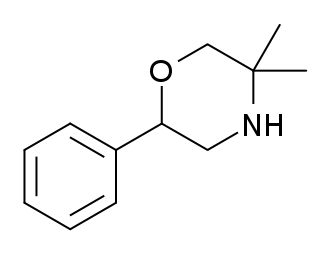Beautiful Plants For Your Interior
Summary
G-130 (also known as GP-130 or 2-Phenyl-5,5-dimethyltetrahydro-1,4-oxazine) is a pharmaceutical compound recognized for its stimulant and anorectic properties, and it shares a chemical relationship with phenmetrazine.
| Identifiers | |
|---|---|
| IUPAC name | |
| CAS Number | 42013-48-9 |
|---|---|
| PubChem CID | 97711 |
| ChemSpider | 88190 |
| UNII | 785F2C727T |
| CompTox Dashboard (EPA) | DTXSID40963342 |
| Chemical and physical data | |
| Formula | C12H17NO |
| Molar mass | 191.274 g·mol−1 |

Synthesis

Ex 1: 2 moles of 2-methyl-2-aminopropanol (aminomethyl propanol) (1) is reacted with 1 moles of styrene oxide (phenyloxirane) [96-09-3] (2) in 0.2 mole water.
FAQ
- What is G-130?
- G-130, GP-130, or 2-Phenyl-5,5-dimethyltetrahydro-1,4-oxazine is a chemical compound with stimulant and anorectic effects.
- What are the effects of G-130?
- G-130 is primarily associated with stimulant effects, which can increase alertness and activity, as well as anorectic effects, which reduce appetite.
- How does G-130 work?
- This brief description does not provide the exact mechanism of action of G-130, but it may act through pathways similar to other stimulant and anorectic drugs.
- Is G-130 safe for consumption?
- The safety of G-130 can vary by region and is subject to regulatory restrictions. It is crucial to consult with a healthcare professional and adhere to local laws and regulations before using this substance.
- Is G-130 approved for medical use?
- G-130 is typically not approved for medical use in most countries. Check with regulatory authorities or healthcare experts for specific information regarding its status.
- Are there any known side effects of G-130?
- Specific side effects of G-130 are not mentioned in this brief description. However, like other stimulant and anorectic compounds, it may have potential side effects that should be considered.
- Is G-130 related to any other substances of concern?
- G-130 is related to phenmetrazine, a substance with a history of recreational use. Users should know that related substances may have similar risks and legal consequences.
- Where can I find more information about G-130?
- To access more comprehensive information about G-130, consult scientific literature and reliable sources. When seeking information online, ensure that sources are trustworthy and credible.
- What precautions should I take when considering the use of G-130?
- Approaching any substance cautiously and considering potential risks, side effects, and legal implications is advisable. Always consult a healthcare professional for guidance and stay informed about relevant laws and regulations in your area.
- Is there ongoing research on G-130?
- Scientific research in the field of psychoactive compounds is ongoing. Access information from reputable scientific sources to stay updated on the latest findings and developments related to G-130.
References
- GB 1336732: “Diethanolamine Derivatives.” Published on November 7, 1973. Assigned to Instituto Gentili SPA.
- Fanelli O (June 1973). “Pharmacological and Toxicological Study of a Novel Psychotropic Stimulant: 2-Phenyl-5-Dimethyl-Tetrahydro-1,4-Oxazine, Compared to d,l-Amphetamine, Phenmetrazine, and Pemoline-Mg.” Published in Arzneimittel-Forschung, Volume 23, Issue 6, Pages 810–816. PMID: 4740767.
- Fanelli O, Mazzoncini V, Ferri S (October 1974). “Toxicological and Teratological Study of 2-Phenyl-5,5-Dimethyl-Tetrahydro-1,4-Oxazine Hydrochloride (G 130), a Psychostimulant Drug.” Published in Arzneimittel-Forschung, Volume 24, Issue 10, Pages 1627–1632. PMID: 4479774.
- Fanelli O, Mazzoncini V, Trallori L (December 1974). “Antagonism of Psychostimulant 2-Phenyl-5,5-Dimethyl-Tetrahydro-1,4-Oxazine Hydrochloride (G 130) to Central Nervous System Depressing Drugs. Monoamine Oxidase Inhibitory Activity and Norepinephrine and Serotonin Induced Changes. Comparison with dL-Amphetamine.” Published in Arzneimittel-Forschung, Volume 24, Issue 12, Pages 2025–2029. PMID: 4480283.
- Carroll FI, Muresan AZ, Blough BE, Navarro HA, Mascarella SW, Eaton JB, et al. (March 2011). “Synthesis of 2-(Substituted Phenyl)-3,5,5-Trimethylmorpholine Analogues and Their Effects on Monoamine Uptake, Nicotinic Acetylcholine Receptor Function, and Behavioral Effects of Nicotine.” Published in the Journal of Medicinal Chemistry, Volume 54, Issue 5, Pages 1441–1448. DOI: 10.1021/jm1014555. PMC: 3048909. PMID: 21319801.
- ES508287 (Application Number) identical to ES 8300676 (1983 to Elmu Sa).